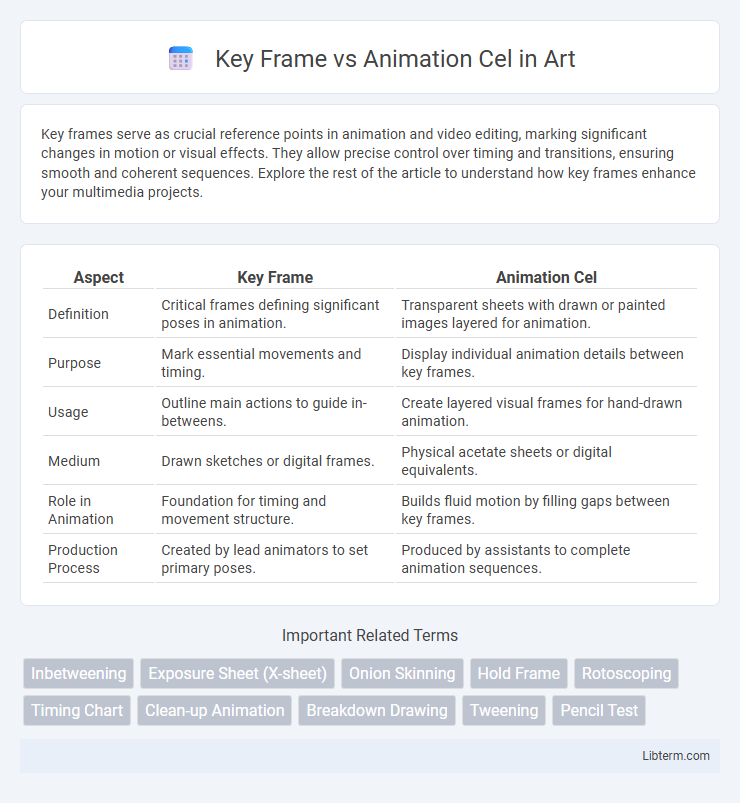Key frames serve as crucial reference points in animation and video editing, marking significant changes in motion or visual effects. They allow precise control over timing and transitions, ensuring smooth and coherent sequences. Explore the rest of the article to understand how key frames enhance your multimedia projects.
Table of Comparison
| Aspect | Key Frame | Animation Cel |
|---|---|---|
| Definition | Critical frames defining significant poses in animation. | Transparent sheets with drawn or painted images layered for animation. |
| Purpose | Mark essential movements and timing. | Display individual animation details between key frames. |
| Usage | Outline main actions to guide in-betweens. | Create layered visual frames for hand-drawn animation. |
| Medium | Drawn sketches or digital frames. | Physical acetate sheets or digital equivalents. |
| Role in Animation | Foundation for timing and movement structure. | Builds fluid motion by filling gaps between key frames. |
| Production Process | Created by lead animators to set primary poses. | Produced by assistants to complete animation sequences. |
Introduction to Key Frames and Animation Cels
Key frames represent specific points in time where essential changes occur in an animation, serving as critical markers that define motion or transformations. Animation cels are transparent sheets on which individual frames are drawn or painted to create the illusion of movement when sequenced. Understanding the distinction between key frames, which outline major transitions, and animation cels, which depict detailed intermediate states, is fundamental to traditional and digital animation techniques.
Historical Evolution of Animation Techniques
Key frames originated in traditional animation as pivotal drawings that define the start and end points of any smooth transition, enabling animators to focus on crucial moments for storytelling. Animation cels, transparent sheets used to hand-paint layers of characters and backgrounds, dominated the industry during the early to mid-20th century before the rise of digital animation. The shift from cel animation to key frame interpolation in computer-generated imagery marked a significant evolution, streamlining production and enhancing animation precision.
Defining Key Frames in Animation
Key frames in animation mark critical points where important changes in movement, position, or expression occur, serving as the foundation for defining the timing and structure of the sequence. Unlike animation cels, which are individual frames painted or drawn for production, key frames establish the essential poses or states that guide the animator in creating smooth transitions. By setting these pivotal moments, key frames enable efficient storytelling through visual rhythm and help animators control motion dynamics with precision.
Understanding Animation Cels
Animation cels are transparent sheets on which individual frames of an animated sequence are hand-drawn or painted, allowing for layering and reuse of background elements. Key frames define the critical points of motion, capturing the main poses or actions that guide the animation process between cels. Understanding animation cels is essential for appreciating how traditional animation achieves fluidity by combining fixed background art with multiple, incrementally altered foreground drawings.
Key Frame Workflow in Modern Animation
Key frame workflow in modern animation relies on defining crucial poses at significant moments, allowing animators to establish the primary structure and timing of a sequence efficiently. This method enables smoother transitions and more precise control over motion compared to the traditional animation cel process, where each frame is drawn separately. Software tools like Adobe Animate and Toon Boom Harmony enhance key frame techniques by automating interpolation, reducing labor while increasing creative flexibility in producing complex animations.
The Role of Animation Cels in Traditional Animation
Animation cels serve as transparent sheets where characters and objects are hand-painted frame by frame, allowing animators to create smooth motion by layering multiple cels over static backgrounds. Unlike key frames that define major poses and transitions, cels capture the in-between movements, enabling fluid animation sequences. This method significantly reduces the workload by reusing backgrounds and only redrawing moving elements, preserving both time and artistic consistency in traditional animation production.
Key Frames vs Animation Cels: Core Differences
Key frames are pivotal drawings that define the start and end points of any smooth transition in animation, establishing critical motion or emotional beats within a sequence. Animation cels, traditionally transparent sheets, hold individual frames painted by hand to create the illusion of movement when played in rapid succession. The core difference lies in their function: key frames serve as structural markers for timing and movement changes, while animation cels constitute the detailed visual content rendered frame-by-frame for the final animated sequence.
Advantages and Limitations of Key Frames
Key frames offer precise control over animation timing and movement by defining critical points in a sequence, enabling smooth transitions and detailed adjustments. They are highly efficient for complex animations requiring scalable edits but demand more skill and time to set up compared to animation cels. However, key frames can be limiting in spontaneous or fluid animations where continuous hand-drawn nuance from cels excels.
Pros and Cons of Animation Cels
Animation cels provide the advantage of allowing artists to create detailed, hand-painted frames that result in rich texture and color fidelity, enhancing the visual quality of traditional animation. However, the process is labor-intensive and time-consuming, requiring meticulous painting and photographing of each cel, which increases production costs and limits flexibility for revisions. Unlike key frames that define primary motion points, animation cels demand extensive resources to produce smooth transitional sequences, making them less efficient for rapid animation workflows.
Choosing Between Key Frames and Animation Cels
Choosing between key frames and animation cels depends on the complexity and style of the animation project. Key frames define critical poses and allow smooth interpolation, making them ideal for digital and 3D animations that require efficient workflow and flexibility. Animation cels, traditionally hand-painted, suit projects demanding detailed, frame-by-frame control and a classic, handcrafted aesthetic.
Key Frame Infographic

 libterm.com
libterm.com